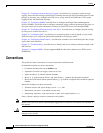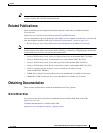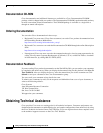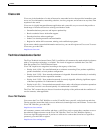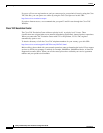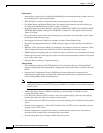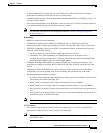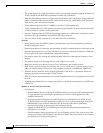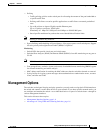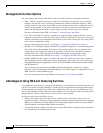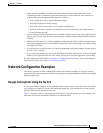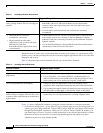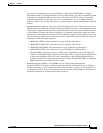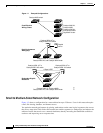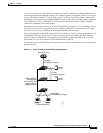
1-4
Catalyst 2950 Desktop Switch Software Configuration Guide
78-11380-05
Chapter 1 Overview
Features
• The switch supports up to 4094 VLAN IDs to allow service provider networks to support the number of
VLANs allowed by the IEEE 802.1Q standard (available only with the EI)
• IEEE 802.1Q trunking protocol on all ports for network moves, adds, and changes; management and
control of broadcast and multicast traffic; and network security by establishing VLAN groups for
high-security users and network resources
• VLAN Membership Policy Server (VMPS) for dynamic VLAN membership
• VLAN Trunking Protocol (VTP) pruning for reducing network traffic by restricting flooded traffic
to links destined for stations receiving the traffic
• Dynamic Trunking Protocol (DTP) for negotiating trunking on a link between two devices and for
negotiating the type of trunking encapsulation (802.1Q) to be used
• Voice VLAN for creating subnets for voice traffic from Cisco IP Phones
Security
• Bridge protocol data unit (BPDU) guard for shutting down a Port Fast-configured port when an
invalid configuration occurs
• Protected port option for restricting the forwarding of traffic to designated ports on the same switch
• Password-protected access (read-only and read-write access) to management interfaces (CMS and
CLI) for protection against unauthorized configuration changes
• Port security option for limiting and identifying MAC addresses of the stations allowed to access
the port
• Port security aging to set the aging time for secure addresses on a port
• Multilevel security for a choice of security level, notification, and resulting actions
• MAC-based port-level security for restricting the use of a switch port to a specific group of source
addresses and preventing switch access from unauthorized stations (available only with the EI)
• Terminal Access Controller Access Control System Plus (TACACS+), a proprietary feature for
managing network security through a TACACS server
• IEEE 802.1X port-based authentication to prevent unauthorized devices from gaining access to the
network
• Standard and extended IP access control lists (ACLs) for defining security policies (available only
with the EI)
Quality of Service and Class of Service
• Classification
–
IP Differentiated Services Code Point (IP DSCP) and class of service (CoS) marking priorities
on a per-port basis for protecting the performance of mission-critical applications (only
available with the EI)
–
Flow-based packet classification (classification based on information in the MAC, IP, and
TCP/UDP headers) for high-performance quality of service at the network edge, allowing for
differentiated service levels for different types of network traffic and for prioritizing
mission-critical traffic in the network (only available in the EI)
–
Support for IEEE 802.1P CoS scheduling for classification and preferential treatment of
high-priority voice traffic
–
Trusted boundary (detect the presence of a Cisco IP phone, trust the CoS value received, and
ensure port security. If the IP phone is not detected, disable the trusted setting on the port and
prevent misuse of a high-priority queue.)



